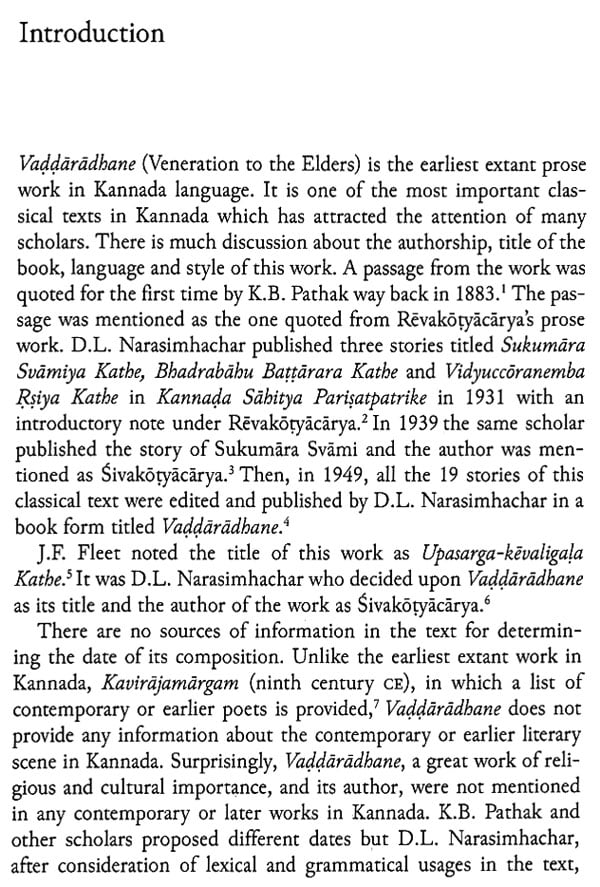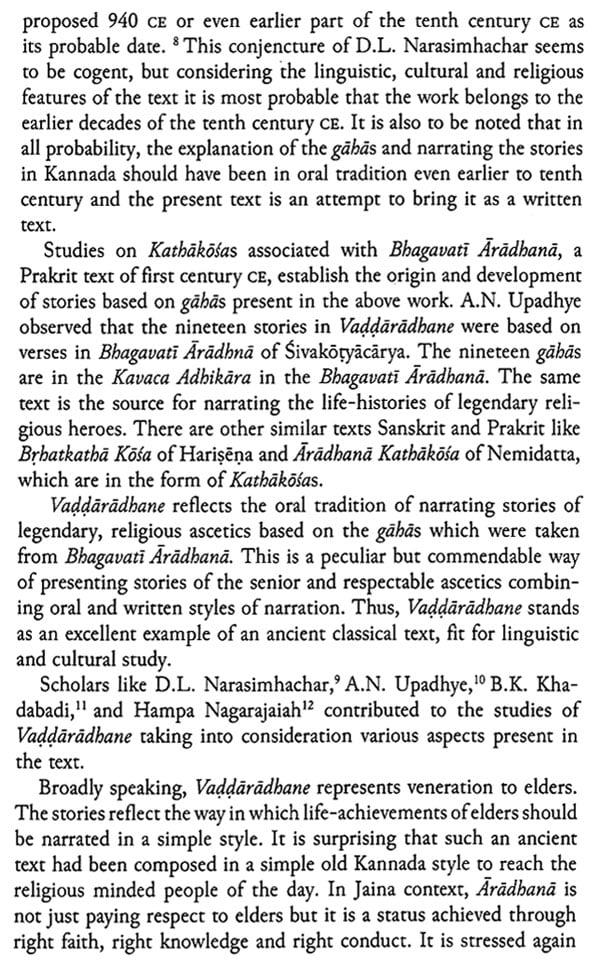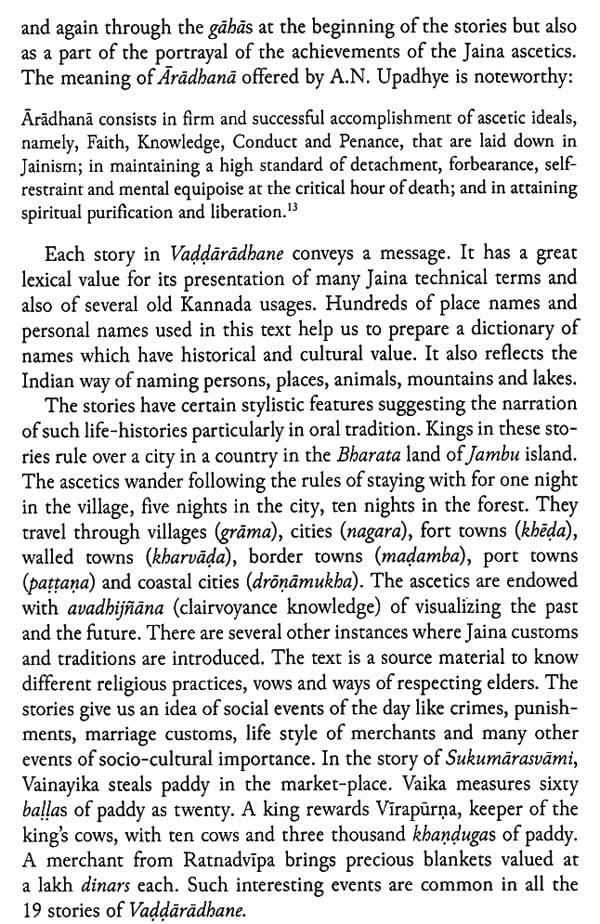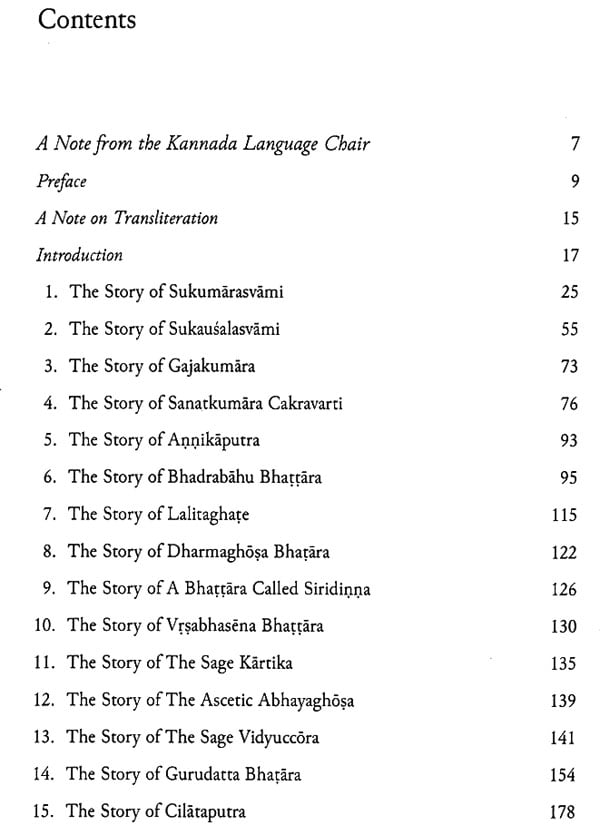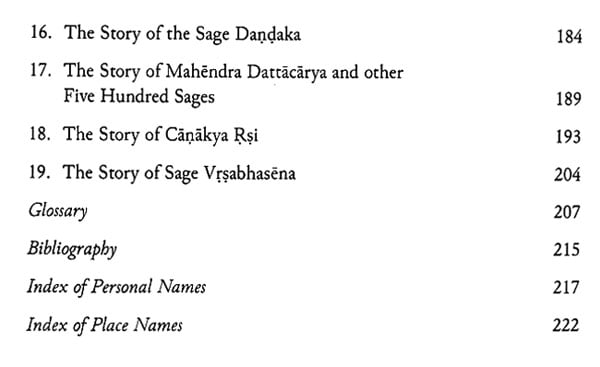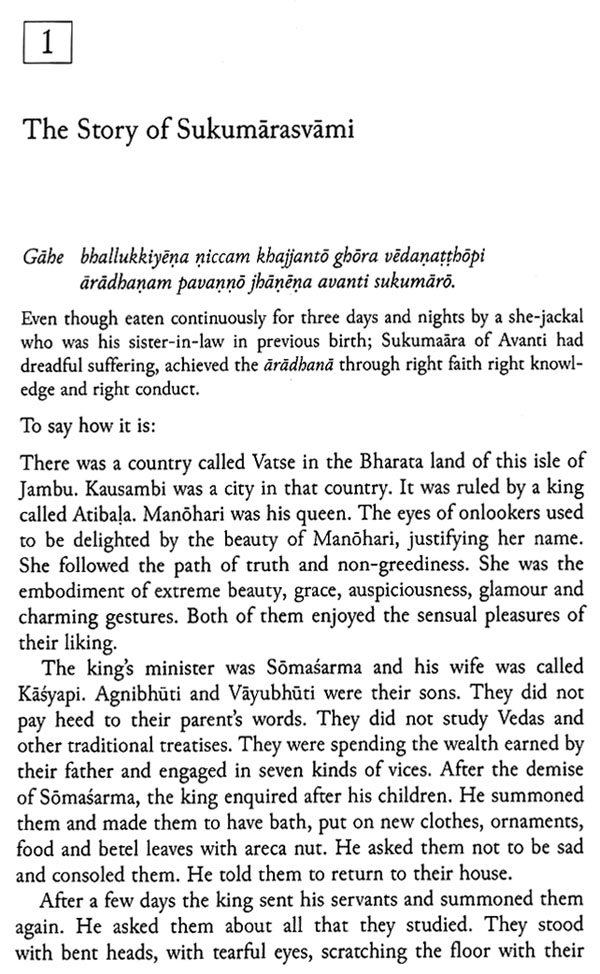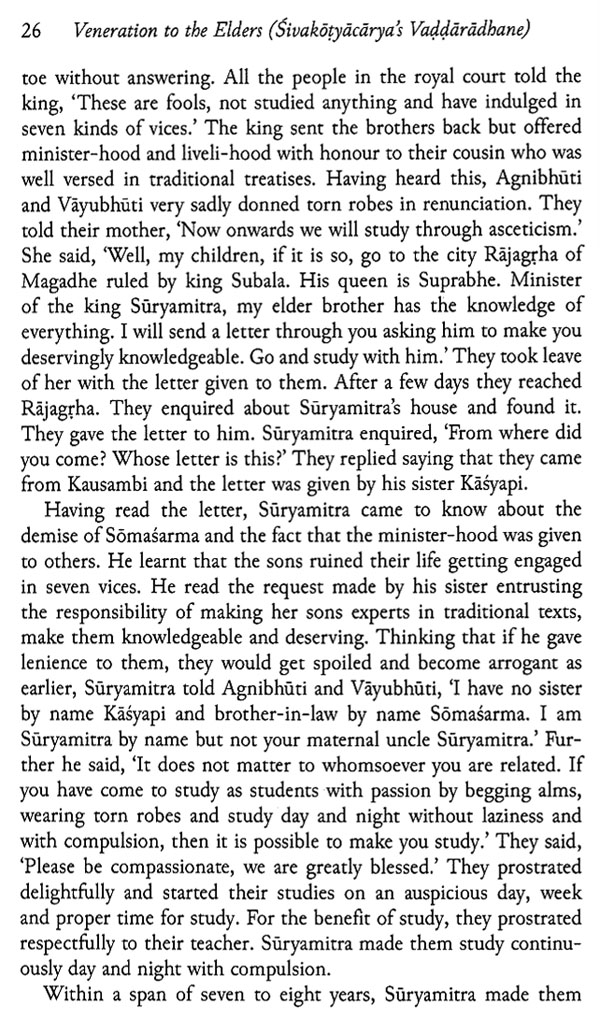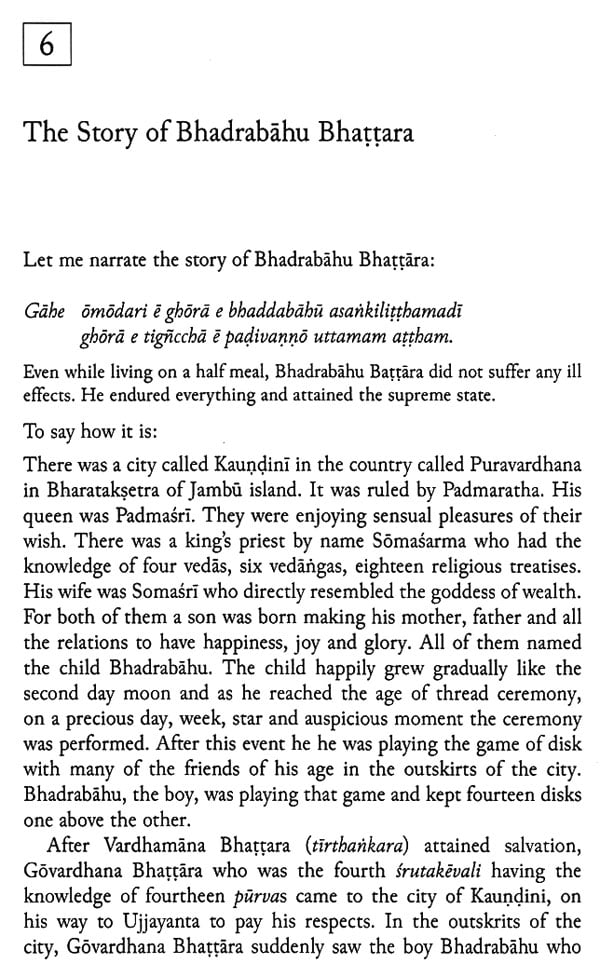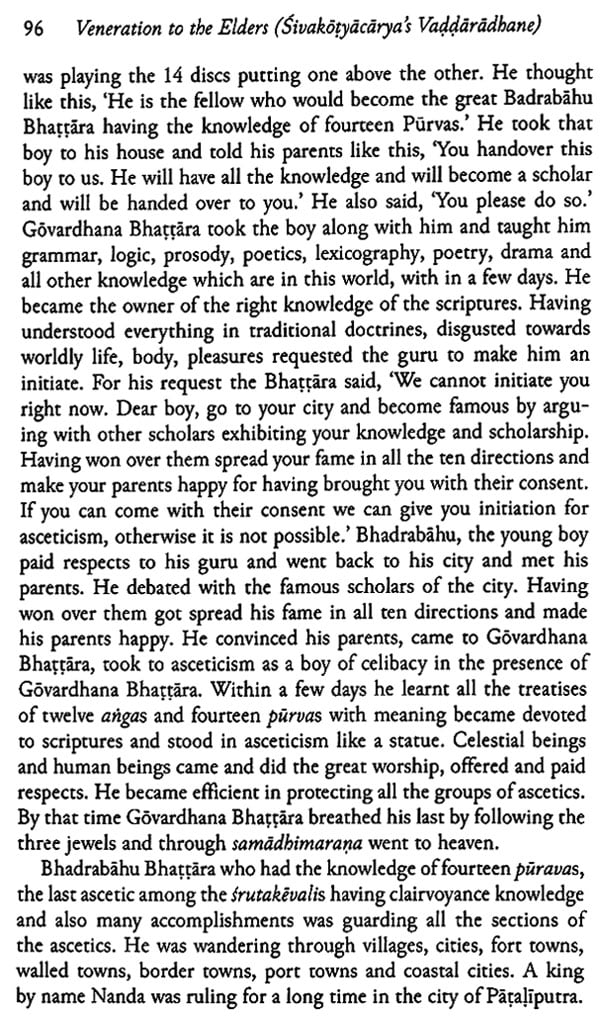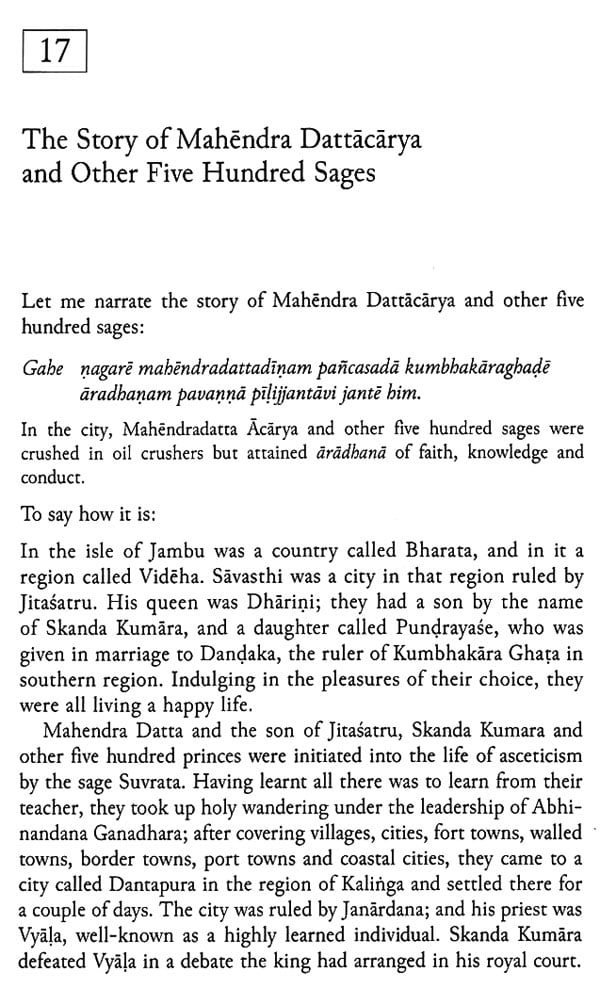
Veneration to the Elders (Sivakotyacarya's Vaddaradhane)
Book Specification
| Item Code: | NAZ238 |
| Author: | R.V.S. Sundaram , Shubhachandra and H.S. Komalesha |
| Publisher: | Manohar Publishers and Distributors |
| Language: | English |
| Edition: | 2020 |
| Pages: | 224 |
| Cover: | HARDCOVER |
| Other Details | 9.00 X 6.00 inch |
| Weight | 400 gm |
Book Description
I think it is wise to stay with the wise and, therefore, without getting involved in the nitty-gritty of the place and the title and the question of authorship, I choose to stay with the considered judgment of scholars of repute that, for all practical and literary purposes, the title of our text is Vaddaradhane, the author’s name Shivakotyacharya and the date of its composition is about CE 920. This almost generally accepted view makes Vaddaradhane the most ancient extant work in Kannada and equally significant, it makes Vaddaradhane the earliest creative prose work in Kannada. It also needs to be remembered that Vaddaradbane is, in an important sense, the inaugurator of a tradition of writing which combines in itself, in a pre-eminently creative embrace, religion and literature, ethics and aesthetics and pleasure and spiritual illumination. Pampa, the first great Kannada poet, is the finest exemplar of this glorious tradition.
Vaddaradhane is a collection of nineteen stories narrated by Shivakotyacharya and these stories have their source in the eleventh century Bribatkatha Kosha of Harishena in Sanskrit. Each story is preceded by a Prakrit Gabe which prescribes most succinctly the theme of the story that presents the details whatever. These Gabes are in the first century Bhagavathi Aradbana of Shivakoti.
Each of the central characters in here is a Purusha Simha, a man- lion or a heroic figure and each is a hero-religious who attempts heroically to earn for himself Moksha or final liberation absolute. But in this attempt to realize this wish there are various and several obstacles and each related either to the body or the mind or the soul and each in the relation to final, absolute liberation.
The struggle is basically a struggle human has in an inalienable part of actual living of a human being. What the individual goes through is similar to or identical with the struggles are the tribulations one sees in Everyman, facing, resisting and overcoming temptations of the flesh and the spirit.
I choose ‘Annikaputra’, the shortest story in this collection, as an illustrative text but before that I would like to draw the attention of the reader to the introductory part of the text. The writer, in the true Indian authorial tradition bows to Sri Vardhamana, offers him salutations and then presents his intention with which he writes the text:
I bow to Vardhaman Jina who is an embodiment of that knowledge which is absolute and who, to all the three words, is like a mirror which reflects this pure consciousness untouched by any impurity.
And I narrate the stories of great men who through severe penance triumphed over twenty two kinds of obstacles which come in the way of one who strives after moksha or final, absolute liberation from all worldly fetters.
The story of Annikapura is the shortest in this collection and its prose is remarkable: sentences are short and simple and clear with hardly any rhetorical flourishes:
In Jambu Dwipa is located Bharata and in Bharata there is Magadha and to its north is Madhura. Its king is Prajapala whose wife is Suprabhe and they live happily enjoying all desired sensual pleasures. In the same town there is Dhanadatta, a Vaishya, who owns a large caravan and has a prosperous business. His wife is Dharani and they have a son called Dhanadeva.
Sometime later Dhanadeva, with a large caravan, carries a huge treasury, goes to south Madhura and there he comes across a royal Vaishya merchant called Tilaka Shresti whose wife is Nande and they have eight daughters among whom the youngest is the loveliest and is named Annika and she is given in marriage to Dhanadeva. They live there for a short time. Dha- nadeva is busy buying and selling and makes a big fortune, much bigger than what he has brought with him. A little later Annika gives birth to a baby boy and he is called Annikaputra or the son of Annika. The boy, in the course of time, grows and becomes a handsome young man.
Time passes by and one day Damasuri, a sage with powers to look into the future, comes to the town and gives discourses on religion and dharmic values.
Dhanadeva goes to the sage and asks how long he is going to live. The sage says, ‘You have a small number of years to live.’ After listening to this prediction, Dhanadeva abandons all worldly desires, parts from his parents and relatives and friends and like a Jain Savana studies all scrip- tures that need to be studied and then goes on a pilgrimage. Desiring to visit the Ganga region he gets into a boat and, as the boat moves up the river there rises a huge wild wind and the boat drowns. But Annika’s son is unperturbed and unaffected and calmly accepts his fate and, standing in Kayotsarga position, gives up his wife and attains to the position of a Kevali.
The pattern we see in this story is virtually the pattern of the each story we have in the collection.
In the midst of a lie of luxury and pleasure, there suddenly happens a traumatic and transforming change for which there isn’t any logical or rational explanation and yet the transforming change rings authentic and right psychologically. The change simply happens silencing all kinds of mundane enquiry. It rather resembles the illogical way in which things happen in folklore or mythology: a parrot foretells the future, a good man turns wicked and a rascal of a man becomes a sage overnight. There is no room here for a why or a how; it simply happens and it is there for all to see and comprehend slowly, magical it certainly looks like and yet is in a subtle way truer than the true.
Although Vaddaradhane is a collection of Dharmic stories which are focused on Jnana, Darshana, Charitra and Tapas or penance which help a human being realize ultimate liberation from all the shackles of living, it presents a world with which we are familiar: the actual, in fact, is the life-breath of these stories and not the abstract tracts or examples of lived truth, although it is those which make Vaddaradhane a unique kind of a religious literary text.
**Sample Pages**
